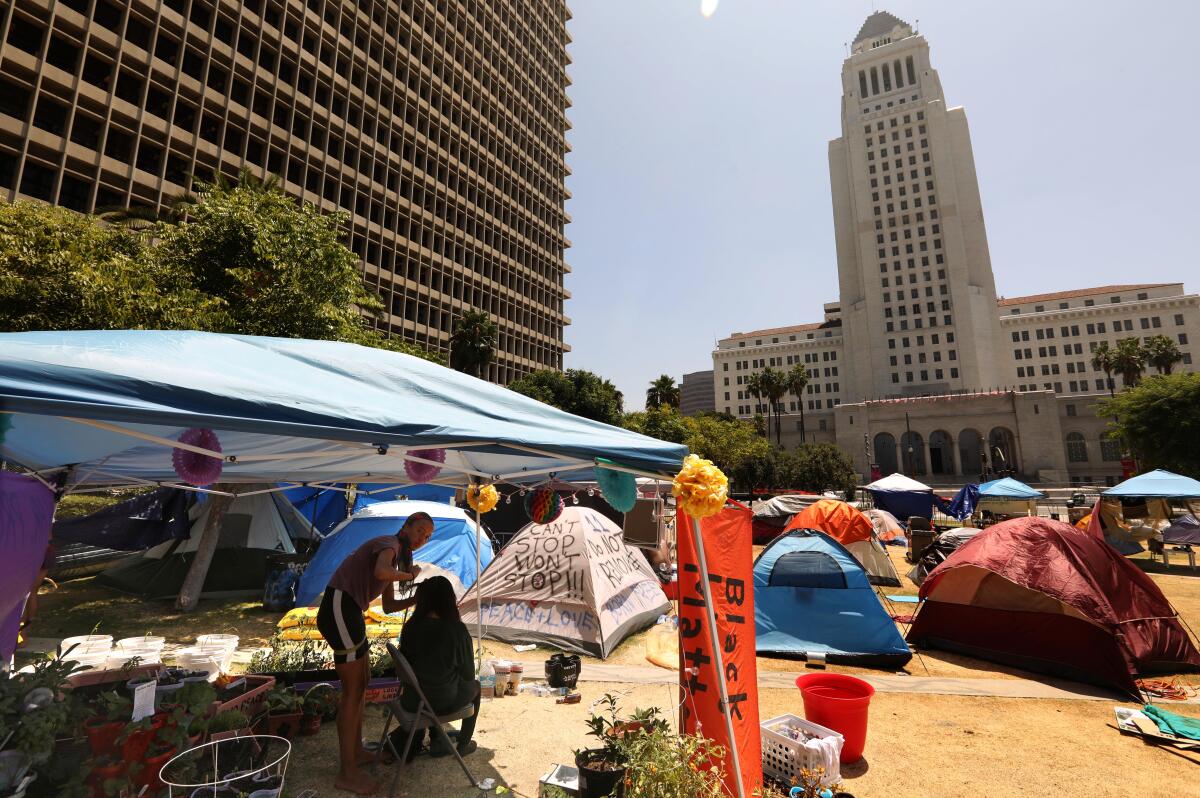Putting homeless people in shelters still leaves them homeless

- Share via
Los Angeles has an unrelenting and growing homelessness crisis. But a proposal the L.A. City Council is considering to shelter or house most of the homeless people in the city would be a disastrous waste of money, time and energy. It would encourage short-term fixes instead of lasting solutions.
The proposal has been floated as a way to settle a federal lawsuit filed last year by the L.A. Alliance for Human Rights, a group of downtown businesses and residents. It would require each of the 15 council districts to offer shelter or housing to 60% of the homeless population in their areas over a five-year period. Whoever is left on the streets and sidewalks after that could be told to stop camping in the area and possibly cited or arrested.
Eventually, when every district has fulfilled the settlement’s requirements, the city could go back to enforcing anticamping ordinances, which have not been widely enforced due to court decisions and, in the past year, the pandemic. The city could fulfill the settlement’s sheltering and housing obligations by offering a homeless person a spot in a safe camping ground, a tiny house, a group shelter or shared house, a hotel or motel room, or an actual apartment.
But given the cost of moving more than 20,000 people off the streets, the city would almost certainly go the quicker, easier route to fulfill the settlement: putting them into temporary shelters.
And then they could call it a day — and take their focus off the only real way to dramatically reduce homelessness, which is providing permanent housing. All the city will have done is move part of its homeless population from encampments and underpasses to tents, tiny homes and other temporary digs in whatever parking lots or unused plots of land officials can find. Unless their circumstances somehow change, the people who aren’t offered shelter or won’t accept it would still be homeless — somewhere.
Rather than solving the homelessness problem, the city will simply have allowed police and sanitation workers to clear homeless people off the streets — which is what a lot of the council members’ constituents want. It’s what the Alliance wants. But it’s not what the mayor and council should do. It’s not right, and they know it. They will have simply shuffled the deck of homeless people around the city. When one council district shelters its 60% and starts compelling the people on its streets to move, they will go to another council district — until they get shooed out of that one.
“The foundation of this is not to house people,” said Councilman Mike Bonin, who has problems with the proposed settlement. “The foundation is to clear sidewalks and to do the least amount necessary to give the city the power to do that.”
The Alliance has argued in its court papers that the city and county governments have allowed skid row, the largest concentration of homeless people in the city (more than 4,600, according to the last homeless count), to grow into a physical and mental health emergency. But in a request for a preliminary injunction filed Monday, the Alliance complains that its members can’t “reasonably enjoy the use of their property” because the city’s actions “have led to the buildup of encampments.”
The Alliance has asked that the city be required to shelter or house everyone on skid row in 90 days — and to make sure that half of them are sheltered outside of skid row. Financially and logistically unfeasible, that’s merely an attempt to clear skid row, not lift people out of homelessness.
However, the city does need interim solutions while it works on creating permanent housing, preferably by building innovative modular housing, leasing apartment buildings, buying motels and hotels for conversion into apartments and offering more vouchers to help homeless people rent units throughout the city.
Any settlement of that lawsuit should contain benchmarks for permanent as well as interim housing. And don’t forget, if we want homeless people to stay in a shelter setting — a sanctioned campground, a tiny-house village, a group shelter — we need to give them what they need from a shelter setting. It’s not that the city can’t create villages of tiny homes or tents. But it can’t do only that. And in its current form, that’s all the proposed settlement encourages.
More to Read
A cure for the common opinion
Get thought-provoking perspectives with our weekly newsletter.
You may occasionally receive promotional content from the Los Angeles Times.










